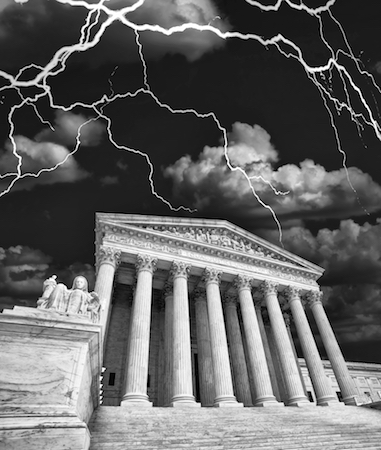Rader’s Ruminations – Patent Eligibility II: How the Supreme Court Ignored Statute and Revived Its Innovation-Killing Two-Step
“Tragically, the Court’s conflation of eligibility and patentability has…largely revived the vague validity tests supposedly outlawed in the 1952 Act.”
The Supreme Court has never quite grasped the distinction between patent eligibility and patentability. Eligibility involves entire subject matter categories or fields of inventive enterprise, like the categories “process, machine, [article of] manufacture, or composition of matter.” 35 U.S.C. 101. Ascertaining eligibility should therefore require little more than checking the patent title and ensuring that, in the words of the venerable Judge Giles Rich, “[the invention] produces a useful, concrete and tangible result.” State Street Bank v. Signature Fin. Group, 149 F. 3d 1368 (Fed. Cir. 1998). In simple terms, Section 101 requires little more for eligibility than a showing that an invention has applied natural principles to achieve a concrete purpose within the expansive categories articulated by Thomas Jefferson in 1793. Patentability, on the other hand, proceeds as a detailed claim-by-claim, feature-by-feature examination of “the conditions and requirements of this title.” 35 U.S.C. 101. Ironically this fundamental distinction that eludes the Supreme Court is explicit in the statutory language of 35 U.S.C. 101 itself.
When the U.S. Government asked the Supreme Court to honor this statutory language and design, the Court gave a ludicrous response: “[We] decline the Government’s invitation to substitute §§102, 103, and 112 inquiries for the better established inquiry under §101.” Mayo v. Prometheus, 566 U.S. 66 (2012) [emphasis supplied]. In the first place, the reference to the “conditions and requirements” of Sections 102, 103, and 112 is already part of Section 101. The Supreme Court’s statement, however, is ludicrous because the only place in the world where eligibility is “better established” than the vast jurisprudence for validity is in U.S. Supreme Court cases alone. And, of course, that jurisprudence does not “establish” any “better” decisional analysis at all. In other words, the Supreme Court justifies its blatant mistake of ignoring the language of the statute by referring to its earlier mistakes! To be clear, the Court’s mistake goes beyond disregarding the statute to virtually replacing the written law with wholly unnecessary judge-made exceptions. See Part 1 of this Eligibility Overview.
The Court’s Long History of Ignoring the Patent Act
Because the Court does not follow the statute, the distinction between patent eligibility and patentability evaporates with damaging consequences. The Patent Act has repeatedly tried to clarify the distinction. In the early 1950s, then-New York patent attorney, Giles S. Rich (later Circuit Judge Rich), and a U.S. Patent and Trademark Office (USPTO) scholar, P. J. Federico, came together to propose amendments to the Patent Act to make sure eligibility was not confused with basic patentability — the claim-by-claim measure of technological advance necessary to deserve a patent. For that reason, the 1952 Act added Section 100 (b) to expressly define a “process” in terms broad enough to ensure that “any new and useful process,” often computer software, would remain eligible in light of quixotic Supreme Court rulings. 35 U.S.C. 101 [emphasis supplied].
For the same reason, the 1952 Act gave life to the word “discovery” from Article 1, Section 8, Paragraph 8, of the U. S. Constitution by putting “or discovered” into Section 101. Without much regard for the statute’s direct approval of discoveries, the Supreme Court in A.M.P. v. Myriad Genetics, 569 U.S. 576 (2013), examined DNA fragments removed from their natural setting and presented for diagnosis and treatment of breast cancer. Again, that molecular structure had never before existed in that isolated form. The Court dismissively declared that the inventor “created nothing,” while conceding that Myriad’s advance was a “[g]roundbreaking, innovative, . . . [and] brilliant discovery.” Id. [emphasis supplied]. In a glaring oversight, the Court did not bother to explain that both the U.S. Constitution (“Inventors [enjoy] the exclusive right to their . . . discoveries”) and the Patent Act (“whoever invents or discovers”) equate invention and discovery. Indeed, this equation makes sense. The U.S. public does not care how it acquires technology, as long as it benefits from the continual “progress of science and useful arts.” See, U.S. Constitution, Article 1. In sum, the Patent Act bristles with terminology to prevent the courts from conflating eligibility and patentability.
The drafters of the 1952 Act were aware that predictability would be a casualty if the two rules lost touch with their separate statutory anchors. Already, the memorable words of Judge Learned Hand had issued a plaintive warning: “[Patentability has become] as fugitive, impalpable, wayward, and vague a phantom as exists in the whole paraphernalia of legal concepts.” Harries v. Air King, 183 F.2d 158 (2d Cir. 1950) [emphasis supplied]. Moreover, Associate Justice Robert H. Jackson cautioned, “[T]he only patent that is valid is one which this [the Supreme] Court has not been able to get its hands on.” Jungersen v. Ostby & Barton Co., 335 U.S. 560 (1949).
In the period leading up to the 1952 Act, the Court had disturbingly jumbled doctrines of eligibility and patentability. See, Funk Brothers v. Kalo Inoculant, 333 U.S. 127 (1948) (Justice Douglas calls the new bacteria combination a “work of nature”; Justice Frankfurter saw the issue as patentability). And even after the 1952 Act, the Court continued to introduce new “phantom” validity tests. Those unpredictable claim-by-claim validity tests proceeded in two steps: First, the Court looked for the “gist” of the invention; Second, the Court examined that gist for a “flash of genius” or an undefined “synergism.” See, Black Rock v. Pavement, 396 U.S. 57 (1969); Sakraida v. Ag Pro Inc.,425 U.S. 273 (1976). The second step was achieved by observing the invention and assessing the Court’s own visceral “gee whizz” reaction to its merits.
A New Two-Step That is Hopelessly Off-Beat
Ironically, despite the express terms of the 1952 Act, the Supreme Court repeated its pattern of returning to confusion. The Court followed the familiar path of its earlier mistakes (Benson, Flook, Funk Bros.) to make them again in Mayo, Myriad, and Alice. And, no surprise here, this renewed modern conflation of eligibility and patentability still performs a two-step dance. The lower courts and the USPTO describe the Supreme Court’s two-step in somewhat misleading terms. According to the lower courts and USPTO, step one asks if the claim is “directed to” one of the three judge-made exceptions; step two then asks if the claim recites “additional elements that amount to significantly more” than those unnecessary exceptions.
Because every invention must use natural laws and phenomena and abstractness remains an undefined “phantom,” it is often not difficult to find some element of a claim within the grasp of the non-statutory exceptions. Therefore, the real decisive two-step examination starts with identifying the “inventive concept” in the claims — not in the claim as a whole, but in any element of the claim. Alice, 134 S. Ct. at 2355 (“We have described . . . this analysis as a search for an ‘”inventive concept—i.e., an element or combination of elements that is ‘sufficient to ensure that the patent in practice amounts to significantly more than a patent upon the [ineligibility exception] itself.’”). This search for a modern inventive concept is almost identical to the search for the “gist” of the invention before the 1952 Act.
Then, as noted above, the second step is a search for “something significantly more” than the expansive judge-made exceptions that have swallowed the statutory rule. The second part of this modern test is again practically identical to the search for some undefined “flash of genius” or “synergism” which judges simply recognize by their reaction (in vast disregard of the dangers of hindsight) upon observation of the invention. The Court says that this “something more” must transcend the “well-known, routine, or conventional,” see, e,g, Mayo, but that inquiry proceeds without reference to prior art to define those generalizations. Again, the courts are seeking some visceral reaction akin to an undefined “flash of genius” to account for an indeterminate “something more” that impresses enough to survive the claim-by-claim eligibility/patentability test. Tragically, the Court’s conflation of eligibility and patentability has thus largely revived the vague validity tests supposedly outlawed in the 1952 Act.
An Impact That’s Impossible to Fully Quantify
It is perhaps impossible to quantify the full impact of the modern eligibility/patentability crisis on U.S. innovation policy. A 2022 Report from the USPTO confirmed: “ . . . the current jurisprudence has altered the landscape for determining patent subject matter eligibility.” USPTO Report to Congress: Patent Eligible Subject Matter: Public views on the current jurisprudence in the United States, June 2022. Even lagging and incomplete statistics will not fully document the shift to trade secrets, the declining availability of financial investment for important areas of R&D, and the patent applications that were not filed or abandoned due to the chilling climate of Mayo, Myriad, and Alice. One account five years after Alice reported: “Over 1,000 patents have been invalidated by the federal courts and the U.S. Patent and Trademark Office’s (USPTO’s) Patent Trial and Appeal Board (PTAB), while over 60,000 patent applications have been abandoned before the USPTO following rejections for patent ineligible subject matter.” Sachs, Robert, Alice: Benevolent Despot or Tyrant, IP Watchdog, August 29, 2019. That report also noted that “the Federal Circuit affirms 89% of lower court decisions invalidating patents” with district courts upholding 57% of motions to invalidate in whole or part under 101. Id.
Next Up: The CAFC Strikes Out
In sum, the Supreme Court has revived a claim-by-claim eligibility/patentability test that has harmed a whole generation of invention. Of course, the Supreme Court has not been alone in this endeavor. The next installment in these ruminations on eligibility will show that the U.S. Court of Appeals for the Federal Circuit has repeatedly struck out when facing softball eligibility/patentability pitches. One simple bit of advice would bring more certainty to judicial efforts to interpret and apply patent law: When all else fails, consult the statute.
Image Source: Deposit Photos
Author: trekandshoot
Image ID: 21374219






